TESCO's Management and Operations: Leadership and Analysis Report
VerifiedAdded on 2023/01/16
|21
|6068
|79
Report
AI Summary
This report provides a comprehensive analysis of leadership, management, and operational strategies within TESCO. It begins by defining the roles and characteristics of managers and leaders, differentiating between their responsibilities and comparing their approaches to risk, vision, and short-term versus long-term goals. The report then evaluates the roles of leaders and the functions of managers in diverse situational contexts, such as product launches and conflict management, highlighting the application of transformational and democratic leadership styles. Furthermore, it delves into the application of various leadership theories, including situational leadership, and key approaches to operations management, underscoring their importance in achieving business objectives. Finally, the report examines factors affecting operations management, including managerial decisions, and provides a conclusion summarizing the key findings. The report utilizes TESCO as a case study to illustrate the practical application of these concepts in a real-world business setting.
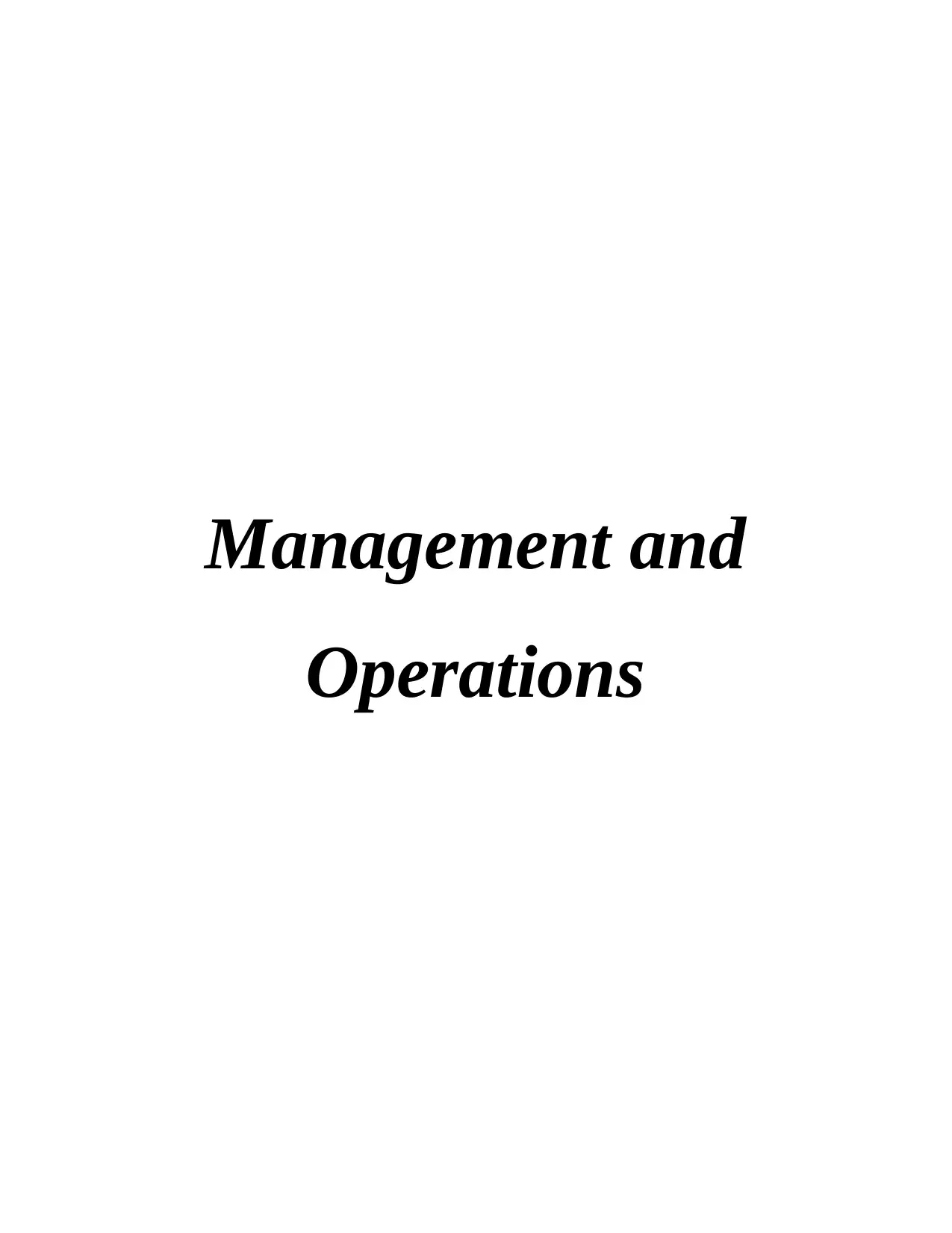
Management and
Operations
Operations
Paraphrase This Document
Need a fresh take? Get an instant paraphrase of this document with our AI Paraphraser
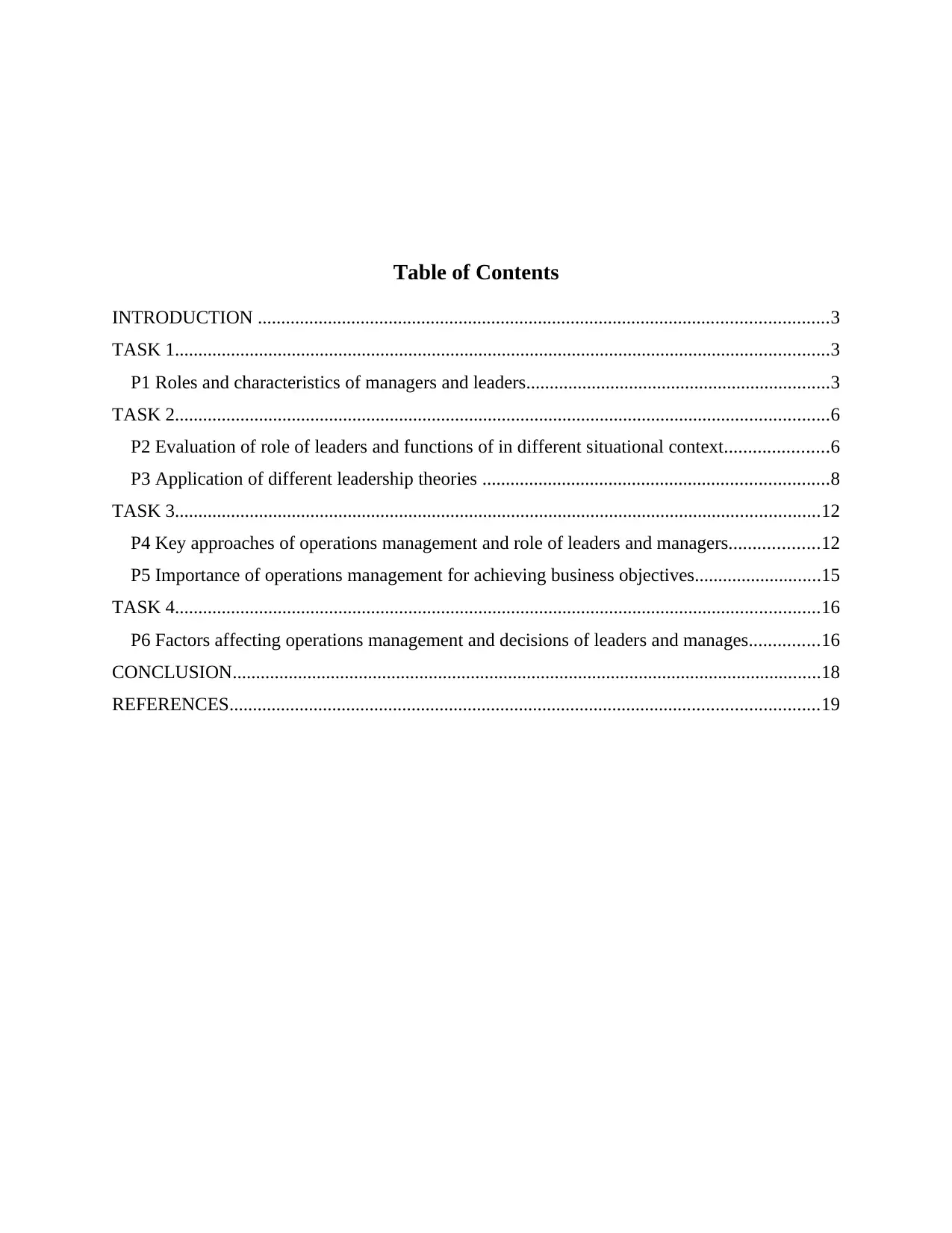
Table of Contents
INTRODUCTION ..........................................................................................................................3
TASK 1............................................................................................................................................3
P1 Roles and characteristics of managers and leaders.................................................................3
TASK 2............................................................................................................................................6
P2 Evaluation of role of leaders and functions of in different situational context......................6
P3 Application of different leadership theories ..........................................................................8
TASK 3..........................................................................................................................................12
P4 Key approaches of operations management and role of leaders and managers...................12
P5 Importance of operations management for achieving business objectives...........................15
TASK 4..........................................................................................................................................16
P6 Factors affecting operations management and decisions of leaders and manages...............16
CONCLUSION..............................................................................................................................18
REFERENCES..............................................................................................................................19
INTRODUCTION ..........................................................................................................................3
TASK 1............................................................................................................................................3
P1 Roles and characteristics of managers and leaders.................................................................3
TASK 2............................................................................................................................................6
P2 Evaluation of role of leaders and functions of in different situational context......................6
P3 Application of different leadership theories ..........................................................................8
TASK 3..........................................................................................................................................12
P4 Key approaches of operations management and role of leaders and managers...................12
P5 Importance of operations management for achieving business objectives...........................15
TASK 4..........................................................................................................................................16
P6 Factors affecting operations management and decisions of leaders and manages...............16
CONCLUSION..............................................................................................................................18
REFERENCES..............................................................................................................................19
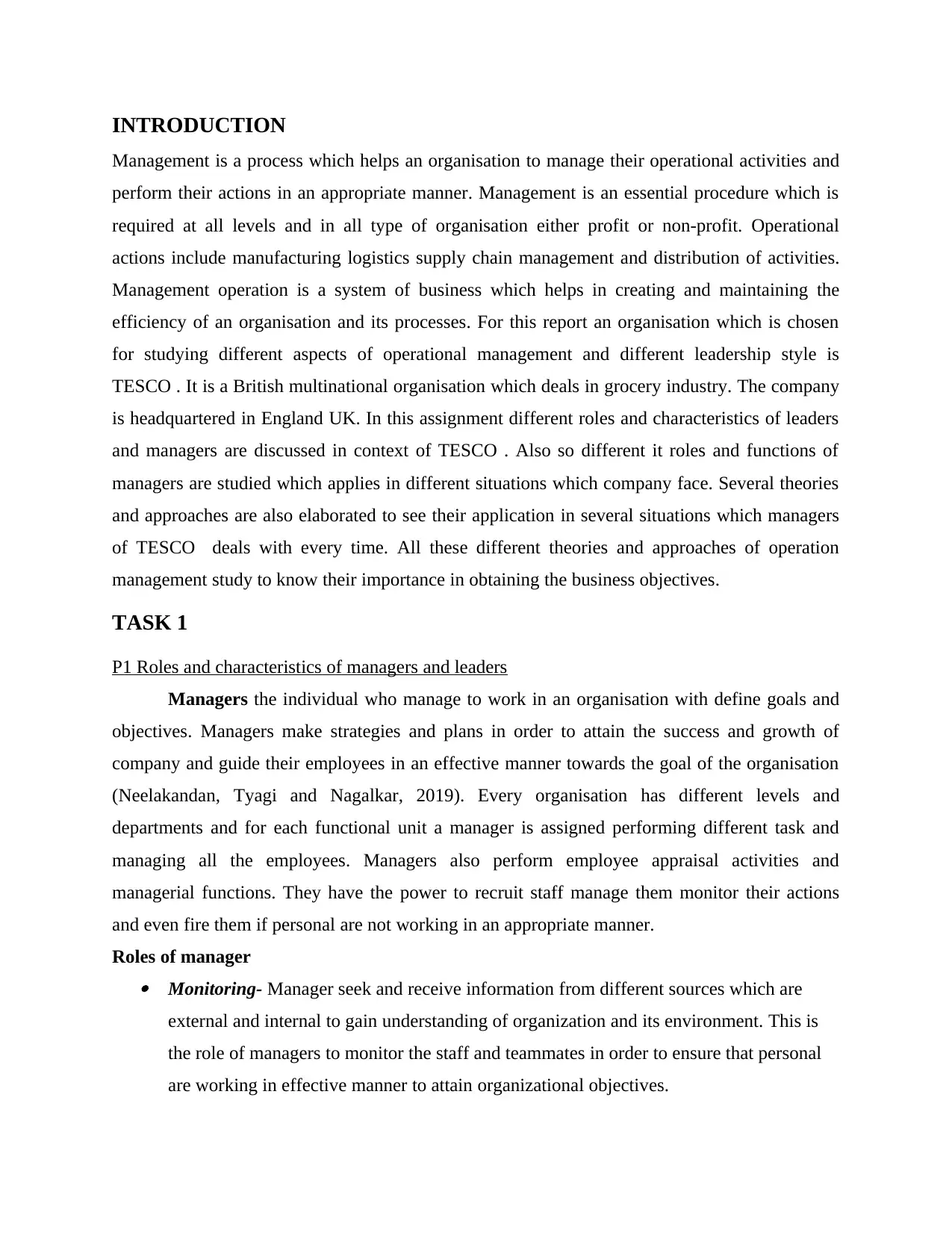
INTRODUCTION
Management is a process which helps an organisation to manage their operational activities and
perform their actions in an appropriate manner. Management is an essential procedure which is
required at all levels and in all type of organisation either profit or non-profit. Operational
actions include manufacturing logistics supply chain management and distribution of activities.
Management operation is a system of business which helps in creating and maintaining the
efficiency of an organisation and its processes. For this report an organisation which is chosen
for studying different aspects of operational management and different leadership style is
TESCO . It is a British multinational organisation which deals in grocery industry. The company
is headquartered in England UK. In this assignment different roles and characteristics of leaders
and managers are discussed in context of TESCO . Also so different it roles and functions of
managers are studied which applies in different situations which company face. Several theories
and approaches are also elaborated to see their application in several situations which managers
of TESCO deals with every time. All these different theories and approaches of operation
management study to know their importance in obtaining the business objectives.
TASK 1
P1 Roles and characteristics of managers and leaders
Managers the individual who manage to work in an organisation with define goals and
objectives. Managers make strategies and plans in order to attain the success and growth of
company and guide their employees in an effective manner towards the goal of the organisation
(Neelakandan, Tyagi and Nagalkar, 2019). Every organisation has different levels and
departments and for each functional unit a manager is assigned performing different task and
managing all the employees. Managers also perform employee appraisal activities and
managerial functions. They have the power to recruit staff manage them monitor their actions
and even fire them if personal are not working in an appropriate manner.
Roles of manager Monitoring- Manager seek and receive information from different sources which are
external and internal to gain understanding of organization and its environment. This is
the role of managers to monitor the staff and teammates in order to ensure that personal
are working in effective manner to attain organizational objectives.
Management is a process which helps an organisation to manage their operational activities and
perform their actions in an appropriate manner. Management is an essential procedure which is
required at all levels and in all type of organisation either profit or non-profit. Operational
actions include manufacturing logistics supply chain management and distribution of activities.
Management operation is a system of business which helps in creating and maintaining the
efficiency of an organisation and its processes. For this report an organisation which is chosen
for studying different aspects of operational management and different leadership style is
TESCO . It is a British multinational organisation which deals in grocery industry. The company
is headquartered in England UK. In this assignment different roles and characteristics of leaders
and managers are discussed in context of TESCO . Also so different it roles and functions of
managers are studied which applies in different situations which company face. Several theories
and approaches are also elaborated to see their application in several situations which managers
of TESCO deals with every time. All these different theories and approaches of operation
management study to know their importance in obtaining the business objectives.
TASK 1
P1 Roles and characteristics of managers and leaders
Managers the individual who manage to work in an organisation with define goals and
objectives. Managers make strategies and plans in order to attain the success and growth of
company and guide their employees in an effective manner towards the goal of the organisation
(Neelakandan, Tyagi and Nagalkar, 2019). Every organisation has different levels and
departments and for each functional unit a manager is assigned performing different task and
managing all the employees. Managers also perform employee appraisal activities and
managerial functions. They have the power to recruit staff manage them monitor their actions
and even fire them if personal are not working in an appropriate manner.
Roles of manager Monitoring- Manager seek and receive information from different sources which are
external and internal to gain understanding of organization and its environment. This is
the role of managers to monitor the staff and teammates in order to ensure that personal
are working in effective manner to attain organizational objectives.
⊘ This is a preview!⊘
Do you want full access?
Subscribe today to unlock all pages.

Trusted by 1+ million students worldwide
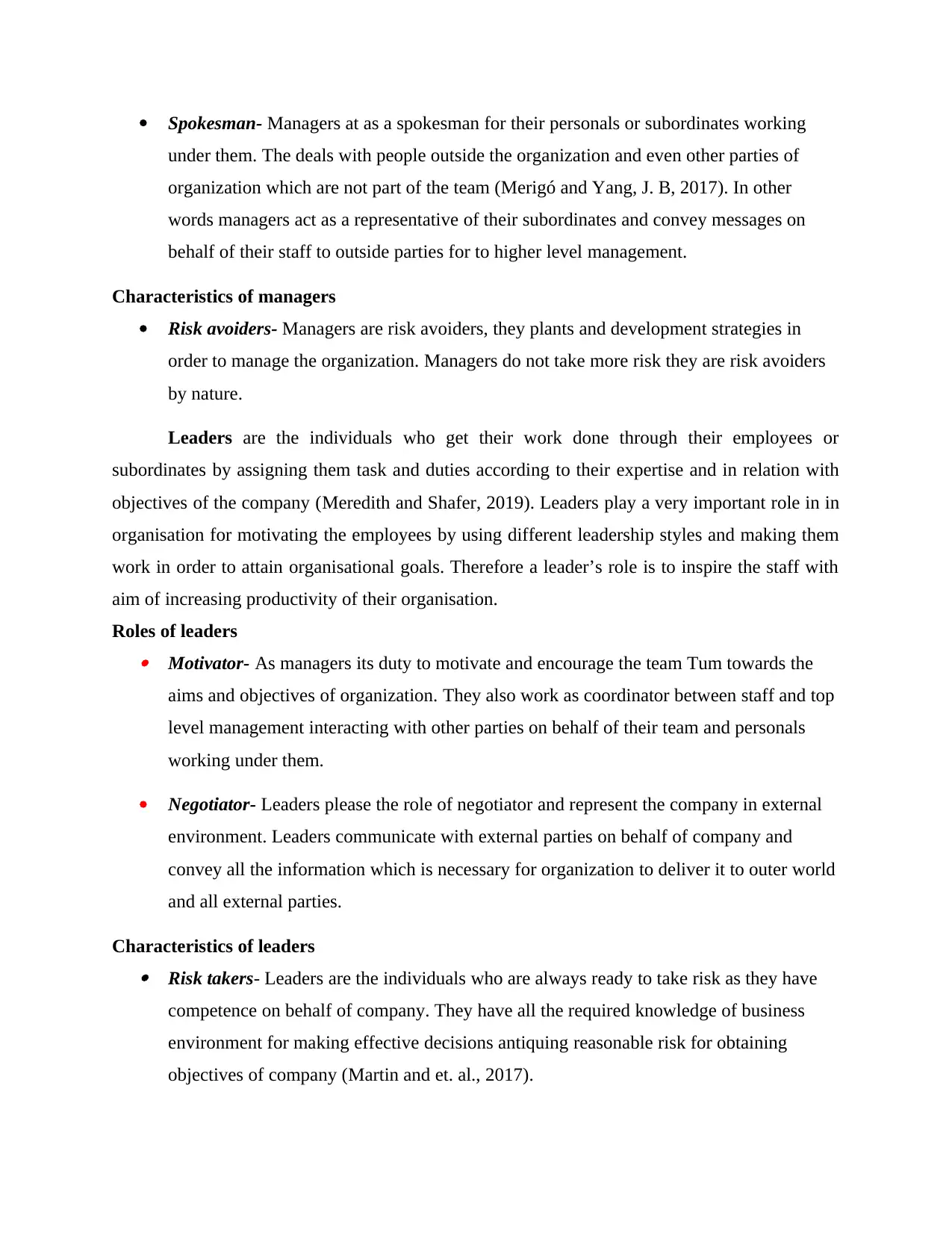
Spokesman- Managers at as a spokesman for their personals or subordinates working
under them. The deals with people outside the organization and even other parties of
organization which are not part of the team (Merigó and Yang, J. B, 2017). In other
words managers act as a representative of their subordinates and convey messages on
behalf of their staff to outside parties for to higher level management.
Characteristics of managers
Risk avoiders- Managers are risk avoiders, they plants and development strategies in
order to manage the organization. Managers do not take more risk they are risk avoiders
by nature.
Leaders are the individuals who get their work done through their employees or
subordinates by assigning them task and duties according to their expertise and in relation with
objectives of the company (Meredith and Shafer, 2019). Leaders play a very important role in in
organisation for motivating the employees by using different leadership styles and making them
work in order to attain organisational goals. Therefore a leader’s role is to inspire the staff with
aim of increasing productivity of their organisation.
Roles of leaders Motivator- As managers its duty to motivate and encourage the team Tum towards the
aims and objectives of organization. They also work as coordinator between staff and top
level management interacting with other parties on behalf of their team and personals
working under them.
Negotiator- Leaders please the role of negotiator and represent the company in external
environment. Leaders communicate with external parties on behalf of company and
convey all the information which is necessary for organization to deliver it to outer world
and all external parties.
Characteristics of leaders Risk takers- Leaders are the individuals who are always ready to take risk as they have
competence on behalf of company. They have all the required knowledge of business
environment for making effective decisions antiquing reasonable risk for obtaining
objectives of company (Martin and et. al., 2017).
under them. The deals with people outside the organization and even other parties of
organization which are not part of the team (Merigó and Yang, J. B, 2017). In other
words managers act as a representative of their subordinates and convey messages on
behalf of their staff to outside parties for to higher level management.
Characteristics of managers
Risk avoiders- Managers are risk avoiders, they plants and development strategies in
order to manage the organization. Managers do not take more risk they are risk avoiders
by nature.
Leaders are the individuals who get their work done through their employees or
subordinates by assigning them task and duties according to their expertise and in relation with
objectives of the company (Meredith and Shafer, 2019). Leaders play a very important role in in
organisation for motivating the employees by using different leadership styles and making them
work in order to attain organisational goals. Therefore a leader’s role is to inspire the staff with
aim of increasing productivity of their organisation.
Roles of leaders Motivator- As managers its duty to motivate and encourage the team Tum towards the
aims and objectives of organization. They also work as coordinator between staff and top
level management interacting with other parties on behalf of their team and personals
working under them.
Negotiator- Leaders please the role of negotiator and represent the company in external
environment. Leaders communicate with external parties on behalf of company and
convey all the information which is necessary for organization to deliver it to outer world
and all external parties.
Characteristics of leaders Risk takers- Leaders are the individuals who are always ready to take risk as they have
competence on behalf of company. They have all the required knowledge of business
environment for making effective decisions antiquing reasonable risk for obtaining
objectives of company (Martin and et. al., 2017).
Paraphrase This Document
Need a fresh take? Get an instant paraphrase of this document with our AI Paraphraser
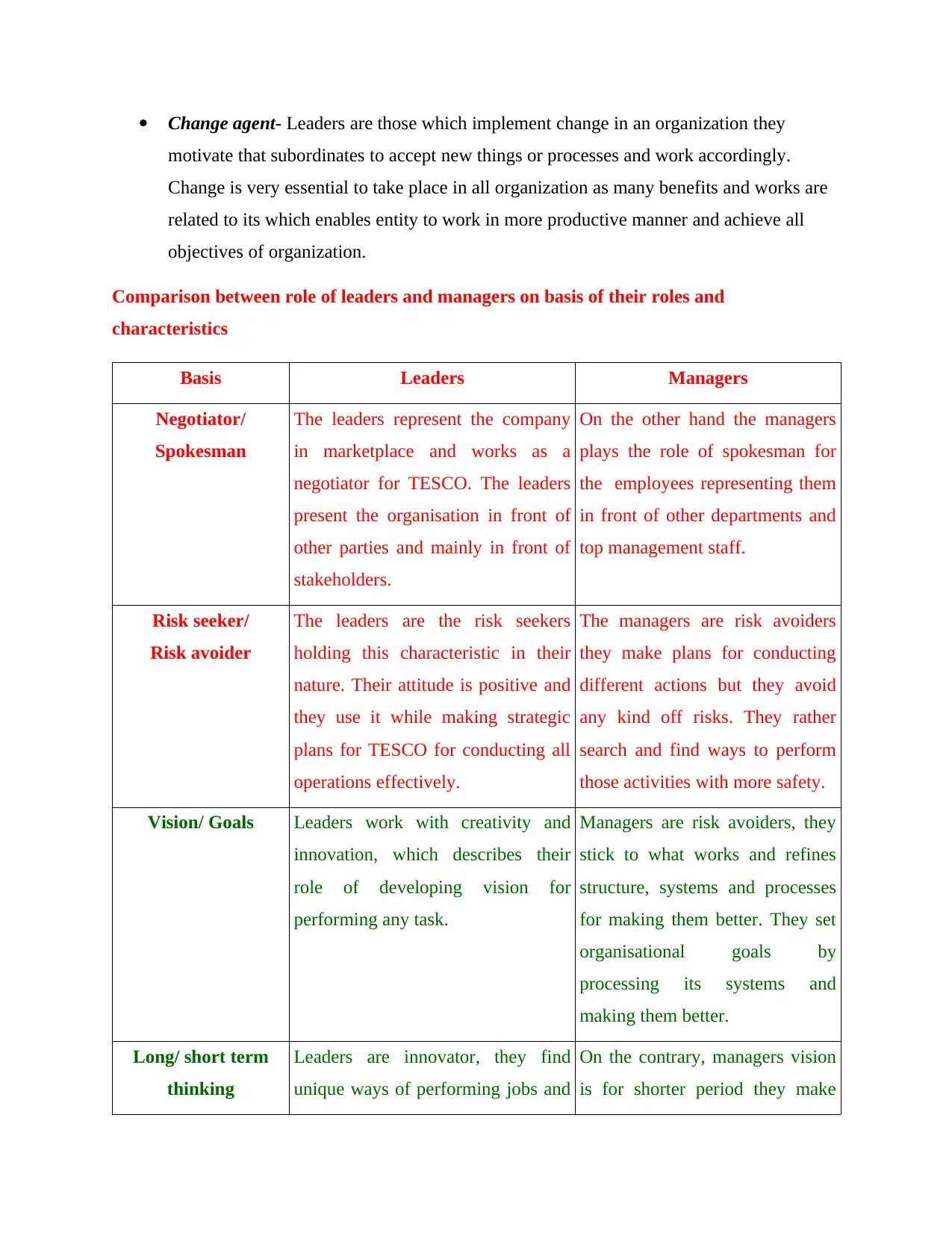
Change agent- Leaders are those which implement change in an organization they
motivate that subordinates to accept new things or processes and work accordingly.
Change is very essential to take place in all organization as many benefits and works are
related to its which enables entity to work in more productive manner and achieve all
objectives of organization.
Comparison between role of leaders and managers on basis of their roles and
characteristics
Basis Leaders Managers
Negotiator/
Spokesman
The leaders represent the company
in marketplace and works as a
negotiator for TESCO. The leaders
present the organisation in front of
other parties and mainly in front of
stakeholders.
On the other hand the managers
plays the role of spokesman for
the employees representing them
in front of other departments and
top management staff.
Risk seeker/
Risk avoider
The leaders are the risk seekers
holding this characteristic in their
nature. Their attitude is positive and
they use it while making strategic
plans for TESCO for conducting all
operations effectively.
The managers are risk avoiders
they make plans for conducting
different actions but they avoid
any kind off risks. They rather
search and find ways to perform
those activities with more safety.
Vision/ Goals Leaders work with creativity and
innovation, which describes their
role of developing vision for
performing any task.
Managers are risk avoiders, they
stick to what works and refines
structure, systems and processes
for making them better. They set
organisational goals by
processing its systems and
making them better.
Long/ short term
thinking
Leaders are innovator, they find
unique ways of performing jobs and
On the contrary, managers vision
is for shorter period they make
motivate that subordinates to accept new things or processes and work accordingly.
Change is very essential to take place in all organization as many benefits and works are
related to its which enables entity to work in more productive manner and achieve all
objectives of organization.
Comparison between role of leaders and managers on basis of their roles and
characteristics
Basis Leaders Managers
Negotiator/
Spokesman
The leaders represent the company
in marketplace and works as a
negotiator for TESCO. The leaders
present the organisation in front of
other parties and mainly in front of
stakeholders.
On the other hand the managers
plays the role of spokesman for
the employees representing them
in front of other departments and
top management staff.
Risk seeker/
Risk avoider
The leaders are the risk seekers
holding this characteristic in their
nature. Their attitude is positive and
they use it while making strategic
plans for TESCO for conducting all
operations effectively.
The managers are risk avoiders
they make plans for conducting
different actions but they avoid
any kind off risks. They rather
search and find ways to perform
those activities with more safety.
Vision/ Goals Leaders work with creativity and
innovation, which describes their
role of developing vision for
performing any task.
Managers are risk avoiders, they
stick to what works and refines
structure, systems and processes
for making them better. They set
organisational goals by
processing its systems and
making them better.
Long/ short term
thinking
Leaders are innovator, they find
unique ways of performing jobs and
On the contrary, managers vision
is for shorter period they make
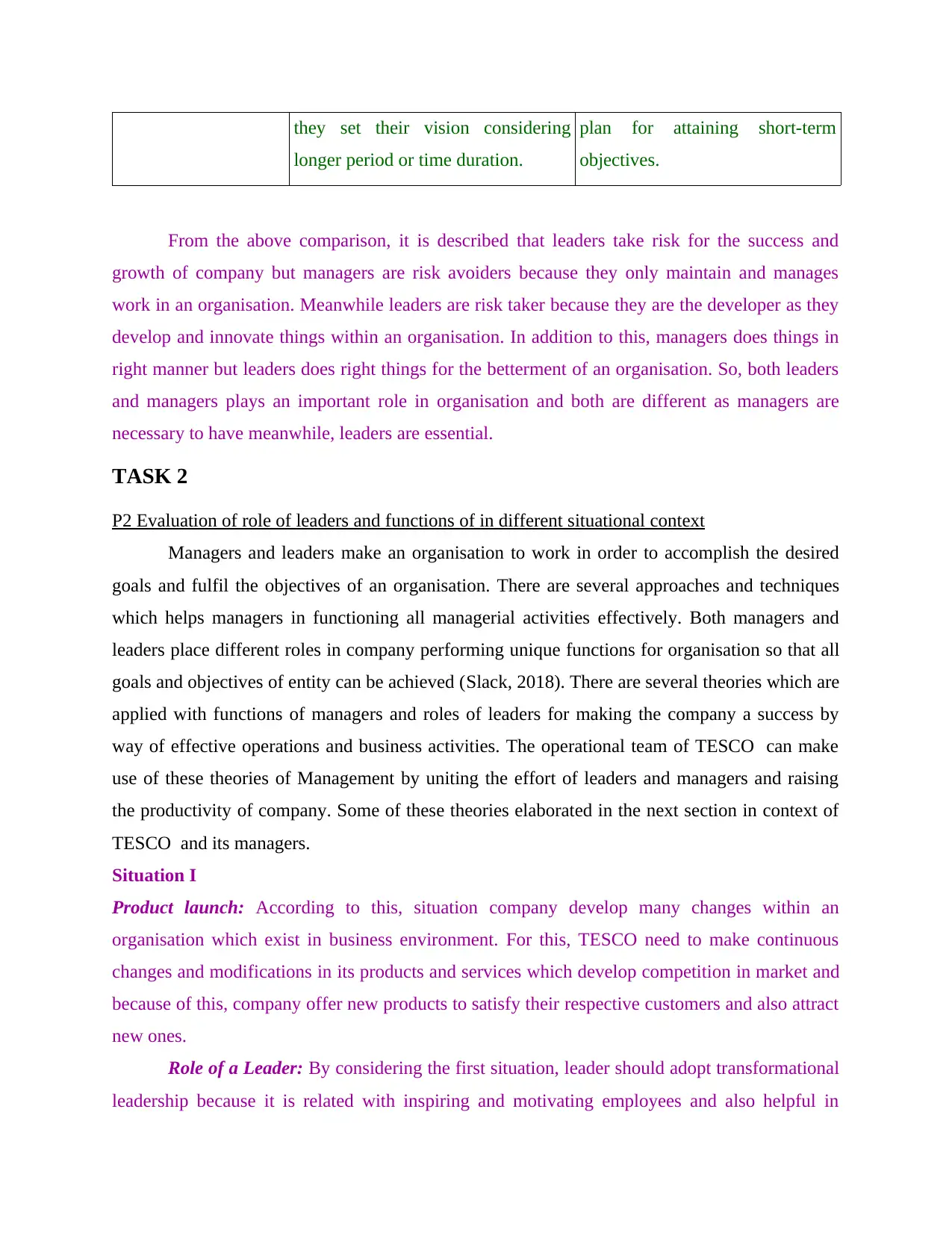
they set their vision considering
longer period or time duration.
plan for attaining short-term
objectives.
From the above comparison, it is described that leaders take risk for the success and
growth of company but managers are risk avoiders because they only maintain and manages
work in an organisation. Meanwhile leaders are risk taker because they are the developer as they
develop and innovate things within an organisation. In addition to this, managers does things in
right manner but leaders does right things for the betterment of an organisation. So, both leaders
and managers plays an important role in organisation and both are different as managers are
necessary to have meanwhile, leaders are essential.
TASK 2
P2 Evaluation of role of leaders and functions of in different situational context
Managers and leaders make an organisation to work in order to accomplish the desired
goals and fulfil the objectives of an organisation. There are several approaches and techniques
which helps managers in functioning all managerial activities effectively. Both managers and
leaders place different roles in company performing unique functions for organisation so that all
goals and objectives of entity can be achieved (Slack, 2018). There are several theories which are
applied with functions of managers and roles of leaders for making the company a success by
way of effective operations and business activities. The operational team of TESCO can make
use of these theories of Management by uniting the effort of leaders and managers and raising
the productivity of company. Some of these theories elaborated in the next section in context of
TESCO and its managers.
Situation I
Product launch: According to this, situation company develop many changes within an
organisation which exist in business environment. For this, TESCO need to make continuous
changes and modifications in its products and services which develop competition in market and
because of this, company offer new products to satisfy their respective customers and also attract
new ones.
Role of a Leader: By considering the first situation, leader should adopt transformational
leadership because it is related with inspiring and motivating employees and also helpful in
longer period or time duration.
plan for attaining short-term
objectives.
From the above comparison, it is described that leaders take risk for the success and
growth of company but managers are risk avoiders because they only maintain and manages
work in an organisation. Meanwhile leaders are risk taker because they are the developer as they
develop and innovate things within an organisation. In addition to this, managers does things in
right manner but leaders does right things for the betterment of an organisation. So, both leaders
and managers plays an important role in organisation and both are different as managers are
necessary to have meanwhile, leaders are essential.
TASK 2
P2 Evaluation of role of leaders and functions of in different situational context
Managers and leaders make an organisation to work in order to accomplish the desired
goals and fulfil the objectives of an organisation. There are several approaches and techniques
which helps managers in functioning all managerial activities effectively. Both managers and
leaders place different roles in company performing unique functions for organisation so that all
goals and objectives of entity can be achieved (Slack, 2018). There are several theories which are
applied with functions of managers and roles of leaders for making the company a success by
way of effective operations and business activities. The operational team of TESCO can make
use of these theories of Management by uniting the effort of leaders and managers and raising
the productivity of company. Some of these theories elaborated in the next section in context of
TESCO and its managers.
Situation I
Product launch: According to this, situation company develop many changes within an
organisation which exist in business environment. For this, TESCO need to make continuous
changes and modifications in its products and services which develop competition in market and
because of this, company offer new products to satisfy their respective customers and also attract
new ones.
Role of a Leader: By considering the first situation, leader should adopt transformational
leadership because it is related with inspiring and motivating employees and also helpful in
⊘ This is a preview!⊘
Do you want full access?
Subscribe today to unlock all pages.

Trusted by 1+ million students worldwide
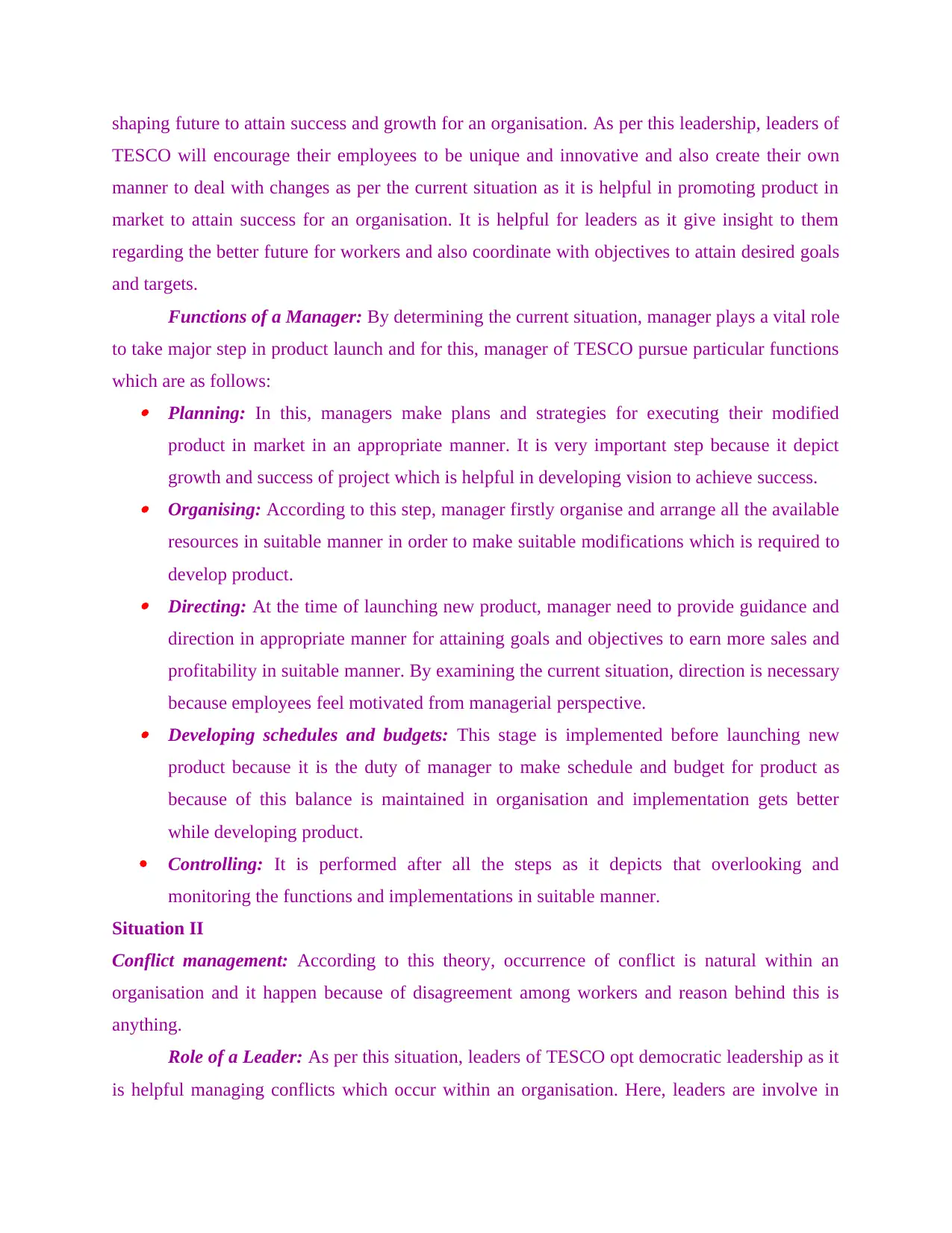
shaping future to attain success and growth for an organisation. As per this leadership, leaders of
TESCO will encourage their employees to be unique and innovative and also create their own
manner to deal with changes as per the current situation as it is helpful in promoting product in
market to attain success for an organisation. It is helpful for leaders as it give insight to them
regarding the better future for workers and also coordinate with objectives to attain desired goals
and targets.
Functions of a Manager: By determining the current situation, manager plays a vital role
to take major step in product launch and for this, manager of TESCO pursue particular functions
which are as follows: Planning: In this, managers make plans and strategies for executing their modified
product in market in an appropriate manner. It is very important step because it depict
growth and success of project which is helpful in developing vision to achieve success. Organising: According to this step, manager firstly organise and arrange all the available
resources in suitable manner in order to make suitable modifications which is required to
develop product. Directing: At the time of launching new product, manager need to provide guidance and
direction in appropriate manner for attaining goals and objectives to earn more sales and
profitability in suitable manner. By examining the current situation, direction is necessary
because employees feel motivated from managerial perspective. Developing schedules and budgets: This stage is implemented before launching new
product because it is the duty of manager to make schedule and budget for product as
because of this balance is maintained in organisation and implementation gets better
while developing product.
Controlling: It is performed after all the steps as it depicts that overlooking and
monitoring the functions and implementations in suitable manner.
Situation II
Conflict management: According to this theory, occurrence of conflict is natural within an
organisation and it happen because of disagreement among workers and reason behind this is
anything.
Role of a Leader: As per this situation, leaders of TESCO opt democratic leadership as it
is helpful managing conflicts which occur within an organisation. Here, leaders are involve in
TESCO will encourage their employees to be unique and innovative and also create their own
manner to deal with changes as per the current situation as it is helpful in promoting product in
market to attain success for an organisation. It is helpful for leaders as it give insight to them
regarding the better future for workers and also coordinate with objectives to attain desired goals
and targets.
Functions of a Manager: By determining the current situation, manager plays a vital role
to take major step in product launch and for this, manager of TESCO pursue particular functions
which are as follows: Planning: In this, managers make plans and strategies for executing their modified
product in market in an appropriate manner. It is very important step because it depict
growth and success of project which is helpful in developing vision to achieve success. Organising: According to this step, manager firstly organise and arrange all the available
resources in suitable manner in order to make suitable modifications which is required to
develop product. Directing: At the time of launching new product, manager need to provide guidance and
direction in appropriate manner for attaining goals and objectives to earn more sales and
profitability in suitable manner. By examining the current situation, direction is necessary
because employees feel motivated from managerial perspective. Developing schedules and budgets: This stage is implemented before launching new
product because it is the duty of manager to make schedule and budget for product as
because of this balance is maintained in organisation and implementation gets better
while developing product.
Controlling: It is performed after all the steps as it depicts that overlooking and
monitoring the functions and implementations in suitable manner.
Situation II
Conflict management: According to this theory, occurrence of conflict is natural within an
organisation and it happen because of disagreement among workers and reason behind this is
anything.
Role of a Leader: As per this situation, leaders of TESCO opt democratic leadership as it
is helpful managing conflicts which occur within an organisation. Here, leaders are involve in
Paraphrase This Document
Need a fresh take? Get an instant paraphrase of this document with our AI Paraphraser
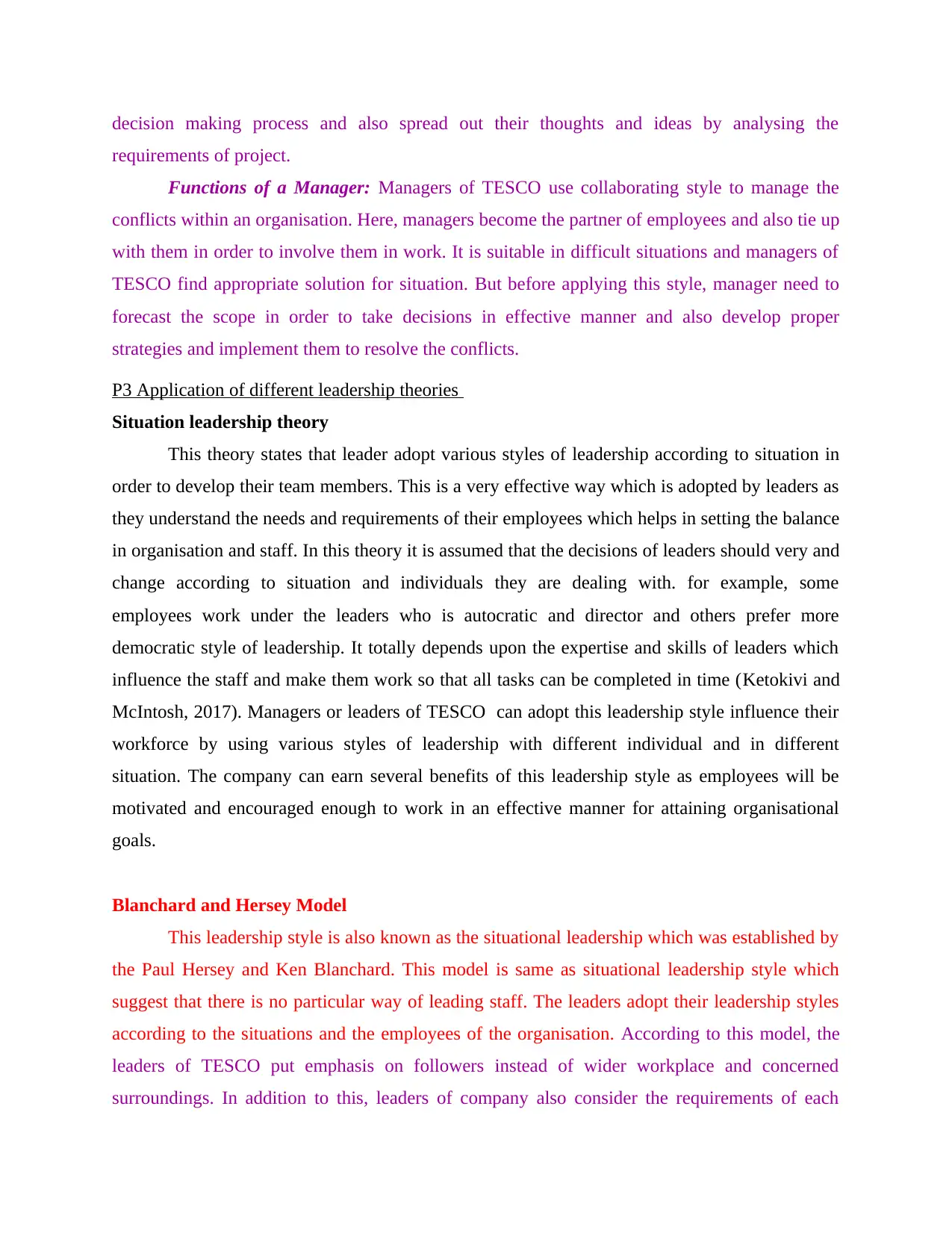
decision making process and also spread out their thoughts and ideas by analysing the
requirements of project.
Functions of a Manager: Managers of TESCO use collaborating style to manage the
conflicts within an organisation. Here, managers become the partner of employees and also tie up
with them in order to involve them in work. It is suitable in difficult situations and managers of
TESCO find appropriate solution for situation. But before applying this style, manager need to
forecast the scope in order to take decisions in effective manner and also develop proper
strategies and implement them to resolve the conflicts.
P3 Application of different leadership theories
Situation leadership theory
This theory states that leader adopt various styles of leadership according to situation in
order to develop their team members. This is a very effective way which is adopted by leaders as
they understand the needs and requirements of their employees which helps in setting the balance
in organisation and staff. In this theory it is assumed that the decisions of leaders should very and
change according to situation and individuals they are dealing with. for example, some
employees work under the leaders who is autocratic and director and others prefer more
democratic style of leadership. It totally depends upon the expertise and skills of leaders which
influence the staff and make them work so that all tasks can be completed in time (Ketokivi and
McIntosh, 2017). Managers or leaders of TESCO can adopt this leadership style influence their
workforce by using various styles of leadership with different individual and in different
situation. The company can earn several benefits of this leadership style as employees will be
motivated and encouraged enough to work in an effective manner for attaining organisational
goals.
Blanchard and Hersey Model
This leadership style is also known as the situational leadership which was established by
the Paul Hersey and Ken Blanchard. This model is same as situational leadership style which
suggest that there is no particular way of leading staff. The leaders adopt their leadership styles
according to the situations and the employees of the organisation. According to this model, the
leaders of TESCO put emphasis on followers instead of wider workplace and concerned
surroundings. In addition to this, leaders of company also consider the requirements of each
requirements of project.
Functions of a Manager: Managers of TESCO use collaborating style to manage the
conflicts within an organisation. Here, managers become the partner of employees and also tie up
with them in order to involve them in work. It is suitable in difficult situations and managers of
TESCO find appropriate solution for situation. But before applying this style, manager need to
forecast the scope in order to take decisions in effective manner and also develop proper
strategies and implement them to resolve the conflicts.
P3 Application of different leadership theories
Situation leadership theory
This theory states that leader adopt various styles of leadership according to situation in
order to develop their team members. This is a very effective way which is adopted by leaders as
they understand the needs and requirements of their employees which helps in setting the balance
in organisation and staff. In this theory it is assumed that the decisions of leaders should very and
change according to situation and individuals they are dealing with. for example, some
employees work under the leaders who is autocratic and director and others prefer more
democratic style of leadership. It totally depends upon the expertise and skills of leaders which
influence the staff and make them work so that all tasks can be completed in time (Ketokivi and
McIntosh, 2017). Managers or leaders of TESCO can adopt this leadership style influence their
workforce by using various styles of leadership with different individual and in different
situation. The company can earn several benefits of this leadership style as employees will be
motivated and encouraged enough to work in an effective manner for attaining organisational
goals.
Blanchard and Hersey Model
This leadership style is also known as the situational leadership which was established by
the Paul Hersey and Ken Blanchard. This model is same as situational leadership style which
suggest that there is no particular way of leading staff. The leaders adopt their leadership styles
according to the situations and the employees of the organisation. According to this model, the
leaders of TESCO put emphasis on followers instead of wider workplace and concerned
surroundings. In addition to this, leaders of company also consider the requirements of each
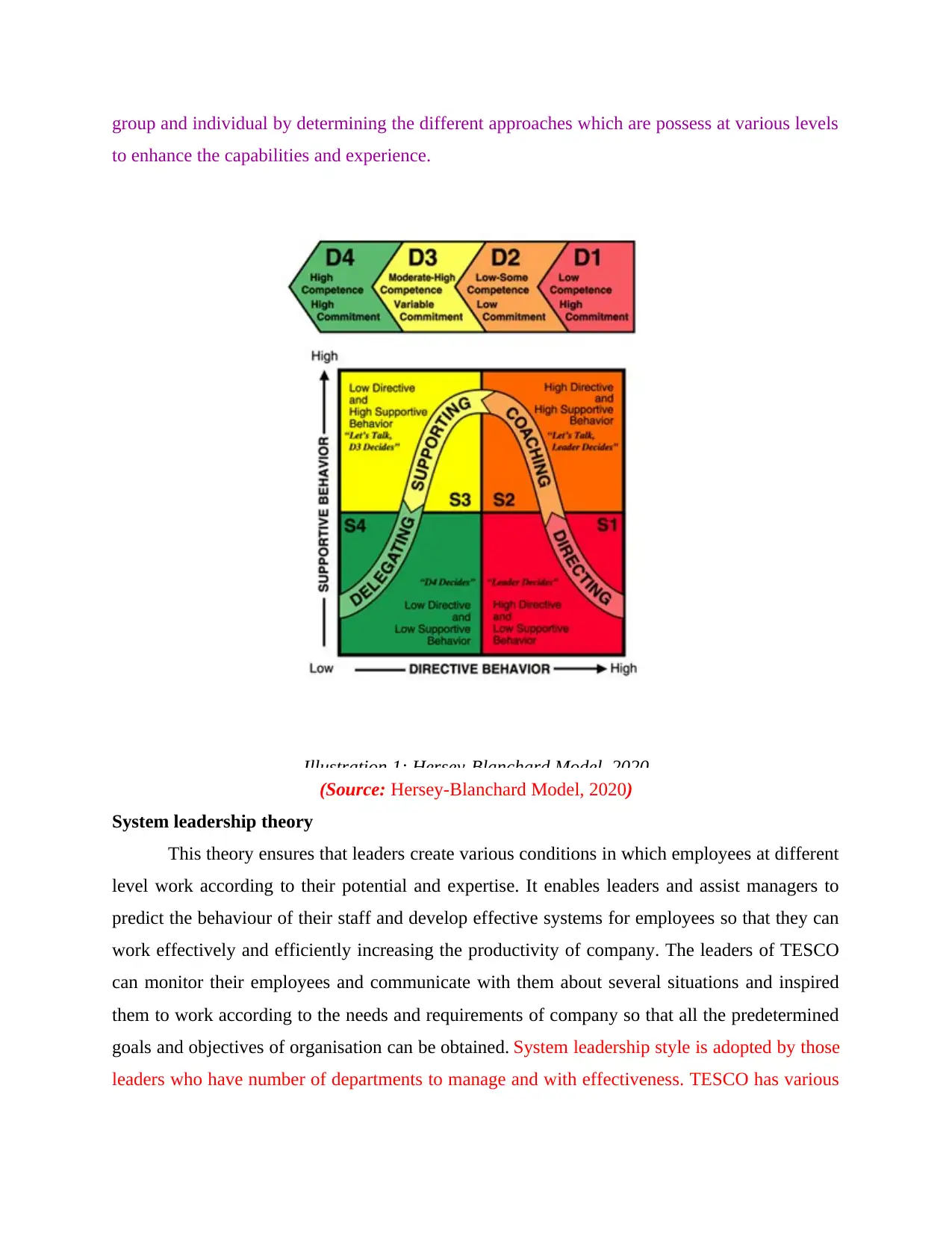
group and individual by determining the different approaches which are possess at various levels
to enhance the capabilities and experience.
(Source: Hersey-Blanchard Model, 2020)
System leadership theory
This theory ensures that leaders create various conditions in which employees at different
level work according to their potential and expertise. It enables leaders and assist managers to
predict the behaviour of their staff and develop effective systems for employees so that they can
work effectively and efficiently increasing the productivity of company. The leaders of TESCO
can monitor their employees and communicate with them about several situations and inspired
them to work according to the needs and requirements of company so that all the predetermined
goals and objectives of organisation can be obtained. System leadership style is adopted by those
leaders who have number of departments to manage and with effectiveness. TESCO has various
Illustration 1: Hersey-Blanchard Model, 2020
to enhance the capabilities and experience.
(Source: Hersey-Blanchard Model, 2020)
System leadership theory
This theory ensures that leaders create various conditions in which employees at different
level work according to their potential and expertise. It enables leaders and assist managers to
predict the behaviour of their staff and develop effective systems for employees so that they can
work effectively and efficiently increasing the productivity of company. The leaders of TESCO
can monitor their employees and communicate with them about several situations and inspired
them to work according to the needs and requirements of company so that all the predetermined
goals and objectives of organisation can be obtained. System leadership style is adopted by those
leaders who have number of departments to manage and with effectiveness. TESCO has various
Illustration 1: Hersey-Blanchard Model, 2020
⊘ This is a preview!⊘
Do you want full access?
Subscribe today to unlock all pages.

Trusted by 1+ million students worldwide
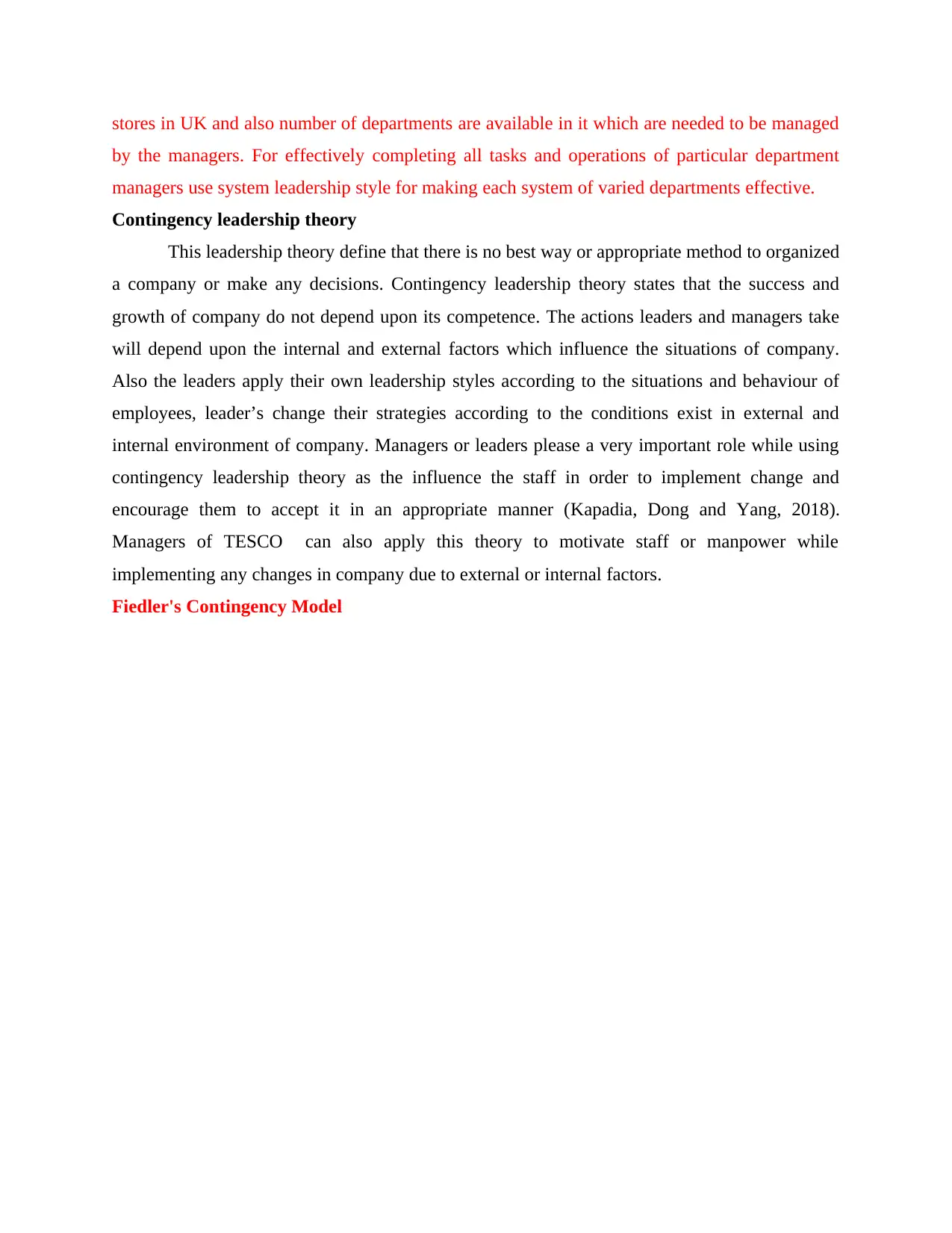
stores in UK and also number of departments are available in it which are needed to be managed
by the managers. For effectively completing all tasks and operations of particular department
managers use system leadership style for making each system of varied departments effective.
Contingency leadership theory
This leadership theory define that there is no best way or appropriate method to organized
a company or make any decisions. Contingency leadership theory states that the success and
growth of company do not depend upon its competence. The actions leaders and managers take
will depend upon the internal and external factors which influence the situations of company.
Also the leaders apply their own leadership styles according to the situations and behaviour of
employees, leader’s change their strategies according to the conditions exist in external and
internal environment of company. Managers or leaders please a very important role while using
contingency leadership theory as the influence the staff in order to implement change and
encourage them to accept it in an appropriate manner (Kapadia, Dong and Yang, 2018).
Managers of TESCO can also apply this theory to motivate staff or manpower while
implementing any changes in company due to external or internal factors.
Fiedler's Contingency Model
by the managers. For effectively completing all tasks and operations of particular department
managers use system leadership style for making each system of varied departments effective.
Contingency leadership theory
This leadership theory define that there is no best way or appropriate method to organized
a company or make any decisions. Contingency leadership theory states that the success and
growth of company do not depend upon its competence. The actions leaders and managers take
will depend upon the internal and external factors which influence the situations of company.
Also the leaders apply their own leadership styles according to the situations and behaviour of
employees, leader’s change their strategies according to the conditions exist in external and
internal environment of company. Managers or leaders please a very important role while using
contingency leadership theory as the influence the staff in order to implement change and
encourage them to accept it in an appropriate manner (Kapadia, Dong and Yang, 2018).
Managers of TESCO can also apply this theory to motivate staff or manpower while
implementing any changes in company due to external or internal factors.
Fiedler's Contingency Model
Paraphrase This Document
Need a fresh take? Get an instant paraphrase of this document with our AI Paraphraser
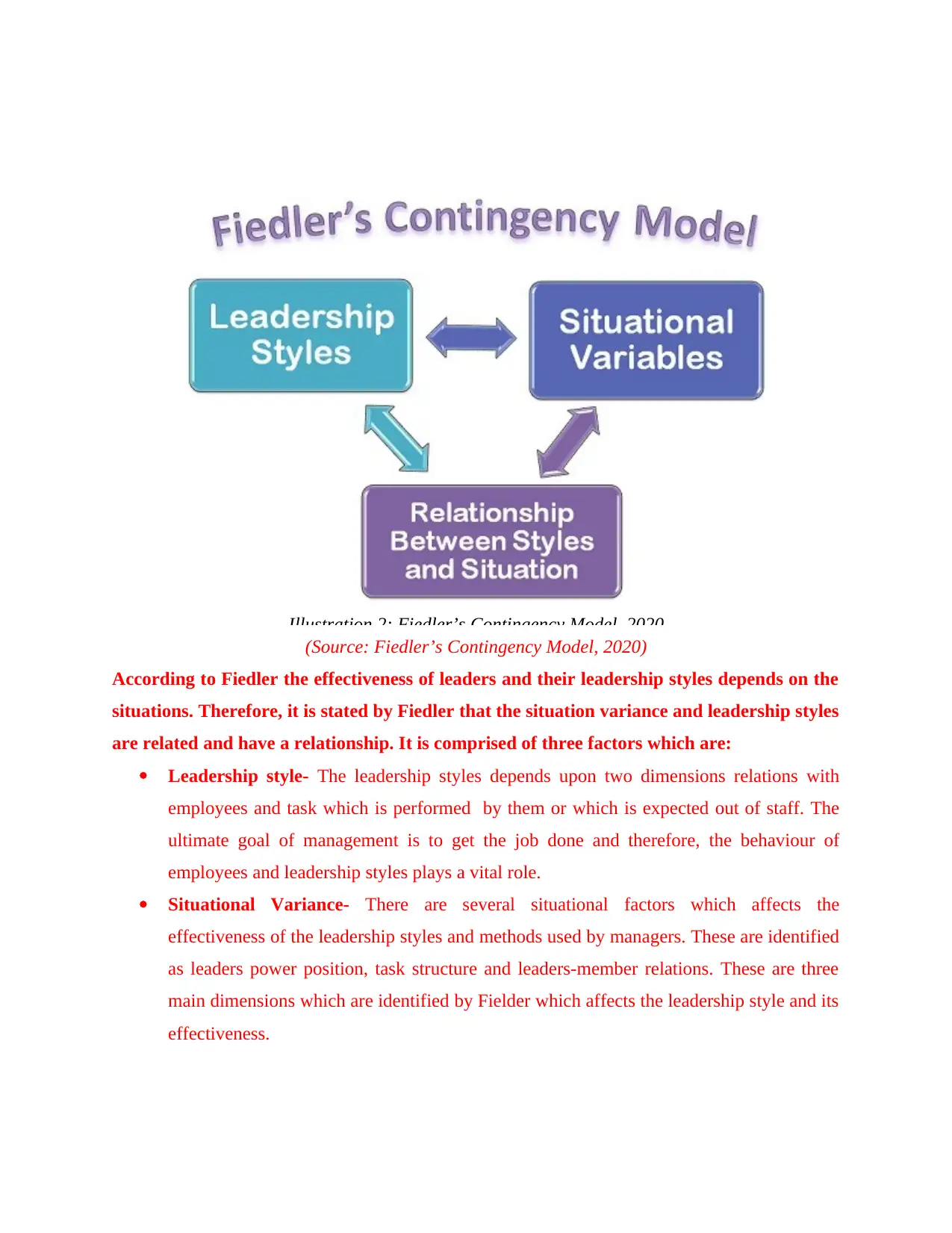
(Source: Fiedler’s Contingency Model, 2020)
According to Fiedler the effectiveness of leaders and their leadership styles depends on the
situations. Therefore, it is stated by Fiedler that the situation variance and leadership styles
are related and have a relationship. It is comprised of three factors which are:
Leadership style- The leadership styles depends upon two dimensions relations with
employees and task which is performed by them or which is expected out of staff. The
ultimate goal of management is to get the job done and therefore, the behaviour of
employees and leadership styles plays a vital role.
Situational Variance- There are several situational factors which affects the
effectiveness of the leadership styles and methods used by managers. These are identified
as leaders power position, task structure and leaders-member relations. These are three
main dimensions which are identified by Fielder which affects the leadership style and its
effectiveness.
Illustration 2: Fiedler’s Contingency Model, 2020
According to Fiedler the effectiveness of leaders and their leadership styles depends on the
situations. Therefore, it is stated by Fiedler that the situation variance and leadership styles
are related and have a relationship. It is comprised of three factors which are:
Leadership style- The leadership styles depends upon two dimensions relations with
employees and task which is performed by them or which is expected out of staff. The
ultimate goal of management is to get the job done and therefore, the behaviour of
employees and leadership styles plays a vital role.
Situational Variance- There are several situational factors which affects the
effectiveness of the leadership styles and methods used by managers. These are identified
as leaders power position, task structure and leaders-member relations. These are three
main dimensions which are identified by Fielder which affects the leadership style and its
effectiveness.
Illustration 2: Fiedler’s Contingency Model, 2020
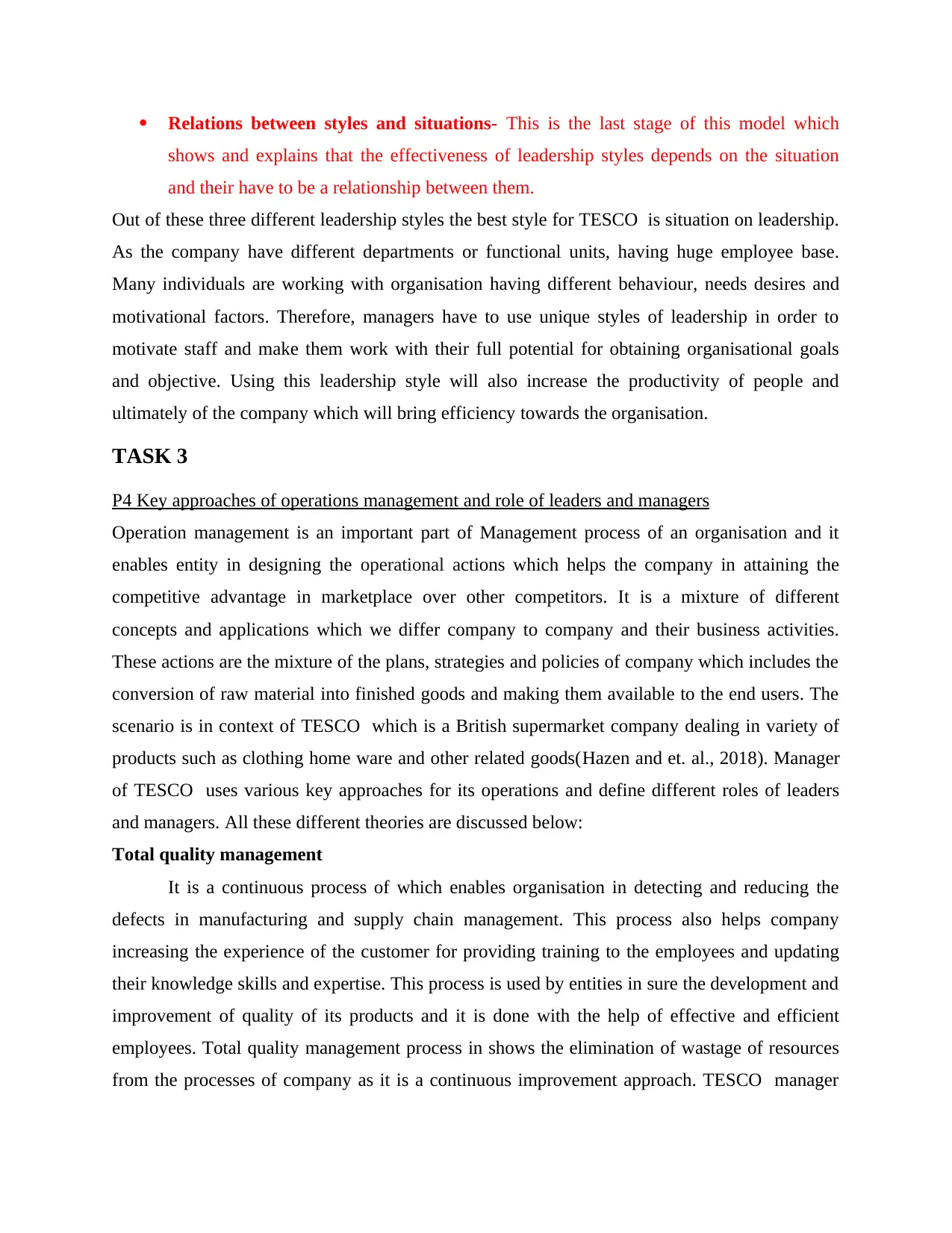
Relations between styles and situations- This is the last stage of this model which
shows and explains that the effectiveness of leadership styles depends on the situation
and their have to be a relationship between them.
Out of these three different leadership styles the best style for TESCO is situation on leadership.
As the company have different departments or functional units, having huge employee base.
Many individuals are working with organisation having different behaviour, needs desires and
motivational factors. Therefore, managers have to use unique styles of leadership in order to
motivate staff and make them work with their full potential for obtaining organisational goals
and objective. Using this leadership style will also increase the productivity of people and
ultimately of the company which will bring efficiency towards the organisation.
TASK 3
P4 Key approaches of operations management and role of leaders and managers
Operation management is an important part of Management process of an organisation and it
enables entity in designing the operational actions which helps the company in attaining the
competitive advantage in marketplace over other competitors. It is a mixture of different
concepts and applications which we differ company to company and their business activities.
These actions are the mixture of the plans, strategies and policies of company which includes the
conversion of raw material into finished goods and making them available to the end users. The
scenario is in context of TESCO which is a British supermarket company dealing in variety of
products such as clothing home ware and other related goods(Hazen and et. al., 2018). Manager
of TESCO uses various key approaches for its operations and define different roles of leaders
and managers. All these different theories are discussed below:
Total quality management
It is a continuous process of which enables organisation in detecting and reducing the
defects in manufacturing and supply chain management. This process also helps company
increasing the experience of the customer for providing training to the employees and updating
their knowledge skills and expertise. This process is used by entities in sure the development and
improvement of quality of its products and it is done with the help of effective and efficient
employees. Total quality management process in shows the elimination of wastage of resources
from the processes of company as it is a continuous improvement approach. TESCO manager
shows and explains that the effectiveness of leadership styles depends on the situation
and their have to be a relationship between them.
Out of these three different leadership styles the best style for TESCO is situation on leadership.
As the company have different departments or functional units, having huge employee base.
Many individuals are working with organisation having different behaviour, needs desires and
motivational factors. Therefore, managers have to use unique styles of leadership in order to
motivate staff and make them work with their full potential for obtaining organisational goals
and objective. Using this leadership style will also increase the productivity of people and
ultimately of the company which will bring efficiency towards the organisation.
TASK 3
P4 Key approaches of operations management and role of leaders and managers
Operation management is an important part of Management process of an organisation and it
enables entity in designing the operational actions which helps the company in attaining the
competitive advantage in marketplace over other competitors. It is a mixture of different
concepts and applications which we differ company to company and their business activities.
These actions are the mixture of the plans, strategies and policies of company which includes the
conversion of raw material into finished goods and making them available to the end users. The
scenario is in context of TESCO which is a British supermarket company dealing in variety of
products such as clothing home ware and other related goods(Hazen and et. al., 2018). Manager
of TESCO uses various key approaches for its operations and define different roles of leaders
and managers. All these different theories are discussed below:
Total quality management
It is a continuous process of which enables organisation in detecting and reducing the
defects in manufacturing and supply chain management. This process also helps company
increasing the experience of the customer for providing training to the employees and updating
their knowledge skills and expertise. This process is used by entities in sure the development and
improvement of quality of its products and it is done with the help of effective and efficient
employees. Total quality management process in shows the elimination of wastage of resources
from the processes of company as it is a continuous improvement approach. TESCO manager
⊘ This is a preview!⊘
Do you want full access?
Subscribe today to unlock all pages.

Trusted by 1+ million students worldwide
1 out of 21
Related Documents
Your All-in-One AI-Powered Toolkit for Academic Success.
+13062052269
info@desklib.com
Available 24*7 on WhatsApp / Email
![[object Object]](/_next/static/media/star-bottom.7253800d.svg)
Unlock your academic potential
Copyright © 2020–2025 A2Z Services. All Rights Reserved. Developed and managed by ZUCOL.




